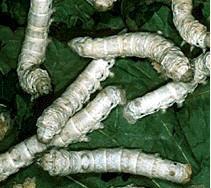
History
The history of
the silkworm, which is also the story of silk, goes back to ancient times in China. Some of the stories have been handed
down through the generations and are probably based party on fact and partly on
legend and myth. The tale which persists is that about 2,640 B.C. a Chinese
empress, Si-Ling-Chi, was watching the glistening
amber cocoons that little worms were spinning in the mulberry trees in the
palace gardens. She unwound one of the threads on a cocoon and found that it
was one, very long strand of shiny material. Fascinated, she pulled strands from
several cocoons through her ring to form a thicker thread. Eventually, with the
help of her ladies of the court, she spun the threads into a beautiful piece of
cloth to make a robe for the emperor, Huang-Ti. This magnificent material,
silk, became known at the "cloth of kings".
For thousand
of years on the royal family of China had silk. The Chinese kept the secret of how silk
was made for 2500 years. The material was sold to the rulers of the West, but
the source of the shiny thread that made the material was not revealed. The
penalty in China for telling that the silk came from the
cocoons of the little silkworms was death! Some very strange ideas were
formulated as to the origin of silk. Here are a few: Silk came from the colored
petals of flowers in the Chinese desert, silk was made of wondrously soft soil,
silk came from a spider-like animal that ate until it burst open and the silk
threads were found inside its body, and silk came from the silky fuzz on
special leaves. These ideas seem far-fetched today -- but in ancient times they
were serious theories.
Legend has it that the Japanese
carried off four Chinese maidens, who knew the secret of silk, along with
mulberry shoots and silk moth eggs. Today Japan is the leading producer of silk! Another
story is that a Chinese princess married an Indian prince. She carried silkworm
eggs and mulberry shoots in her elaborate headdress and the secret of raising
silkworms in her head, thus spreading the culture of silk to India. Finally, two poor monks told Emperor
Justinian of the
Eastern Roman Empire (also called the Byzantine Empire)
that they had learned the secret of
silk. Justinian send them back to China to get some eggs and mulberry shoots for
him. They returned many years later with the eggs and shoots hidden inside
their hollowed-out walking sticks. The secret soon
spread throughout Europe.
[ Back to home page ]
